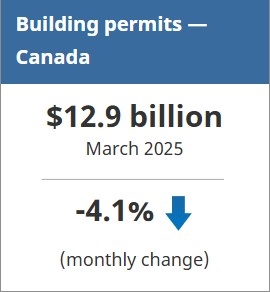Statistics Canada: Building Permits, March 2025

In March, the total value of building permits issued in Canada decreased by $549.4 million (-4.1%) to $12.9 billion. The decrease was led by the non-residential sector (-$716.3 million), and it was tempered by the residential sector (+$166.9 million).
On a constant dollar basis (2017=100), the total value of building permits issued in March decreased 5.1% from the previous month and was up 11.1% on a year-over-year basis.
Commercial construction intentions drive the fall in the non-residential sector
The value of non-residential building permits decreased by $716.3 million to $4.2 billion in March, marking a 14.5% decline from the previous month. Commercial construction intentions led the decline, dropping $474.1 million (-19.0%) to $2.0 billion in March. Meanwhile, the institutional component (-$238.5 million; -14.4%) also saw a decrease. The industrial component (-$3.7 million; -0.5%) experienced a minor decline, continuing its downward trend seen since October 2024.
The reduction in commercial construction intentions in March 2025 was most pronounced in Ontario (-$268.6 million), and it was supported by declines in British Columbia (-$187.1 million), three additional provinces and two territories. Concurrently, Saskatchewan (-$293.7 million) drove the institutional component decrease; this component rose in February, driven by a building permit being issued for a hospital. Losses in the institutional component in March were partially offset by a gain in Ontario (+$121.1 million), supported by construction intentions for long-term care facilities and day care centres in the province. The loss in the industrial component was driven by Alberta (-$152.4 million); there were additional decreases in six provinces and one territory. Ontario’s increase of $177.2 million helped mitigate the overall decline.
Single-family permits slow residential sector growth
Residential construction intentions in Canada increased $166.9 million (+2.0%) in March to reach $8.7 billion. A gain in the multi-family component (+$322.5 million to $5.9 billion) was partially offset by a decline in the single-family component (-$155.6 million to $2.8 billion).
The rise in the multi-family component in March was particularly strong in British Columbia (+$397.8 million), driven by the Vancouver census metropolitan area (CMA) (+$652.3 million).
Meanwhile, the single-family component decrease was primarily observed in Ontario (-$185.7 million) and was supported by Quebec (-$26.0 million).
Overall, 22,800 multi-family dwellings and 4,400 single-family dwellings were authorized for construction in March, representing a 4.6% increase from the previous month.
Quarterly review: British Columbia leads gains in the first quarter
The total value of building permits in the first quarter was $39.1 billion, up 2.9% from the previous quarter ($38.0 billion), a fifth consecutive quarterly increase. British Columbia (+$1.7 billion) led the growth in construction intentions.
The residential sector grew $1.5 billion (+5.9%) to $25.9 billion in the first quarter, fuelled by a gain in the multi-family component (+$1.5 billion; +9.6%) to reach a record high of $17.3 billion. The gain in multi-family construction intentions was concentrated in British Columbia (+$1.2 billion), driven by broad-based growth in the Vancouver CMA.
Meanwhile, single-family construction intentions edged down $55.0 million (-0.6%) to $8.6 billion, with Alberta (-$75.2 million) and Ontario (-$64.1 million) leading the decline. Nova Scotia (+$34.7 million) tempered these losses, along with five other provinces and one territory.
Non-residential construction intentions declined by $354.1 million (-2.6%) to $13.2 billion in the first quarter, a second consecutive quarterly decline. Decreases in the industrial (-$884.5 million) and institutional (-$60.7 million) components were tempered by a gain in the commercial component (+$591.1 million).
To explore data using an interactive user interface, visit the Building permits: Interactive Dashboard.
For more information on construction, please visit the Construction statistics portal.
For more information on housing, please visit the Housing statistics portal.
Note to readers
Unless otherwise stated, this release presents seasonally adjusted data with current dollar values, which facilitate month-to-month and quarter-to-quarter comparisons by removing the effects of seasonal variations. For information on seasonal adjustment, see Seasonally adjusted data – Frequently asked questions.
For information on trend-cycle data, see the page Trend-cycle estimates – Frequently asked questions.
Data may not add up to totals as a result of rounding.
Table 34-10-0285 will be archived and replaced by table 34-10-0292 with the April 2025 reference period, which will be released on June 11, 2025. Data from January 2018 onwards, previously available in table 34-10-0285, remain accessible in the new table, except for the constant dollar series, which will be rebased to 2023=100.
Building components
- Single-family dwellings: Residential buildings containing only one dwelling unit (e.g., single-detached house, bungalow, linked home [linked at the foundation]).
- Multi-family dwellings: Residential buildings containing multiple dwelling units (e.g., apartment, apartment condominium, row house, semi-detached house).
- Industrial buildings: Buildings used in the processing or production of goods or related to transportation and communication.
- Commercial buildings: Buildings used in the trade or distribution of goods and services, including office buildings.
- Institutional and government buildings: Buildings used to house public and semi-public services, such as those related to health and welfare, education or public administration, and buildings used for religious services.
Revision
Data are subject to revisions based on late responses, methodological changes and classification updates. Unadjusted data have been revised for the previous month and from January 2024 to December 2024. Seasonally adjusted data have been revised back to January 2021.
Next release
Data on building permits for April will be released on June 11.
Source: Statistics Canada


